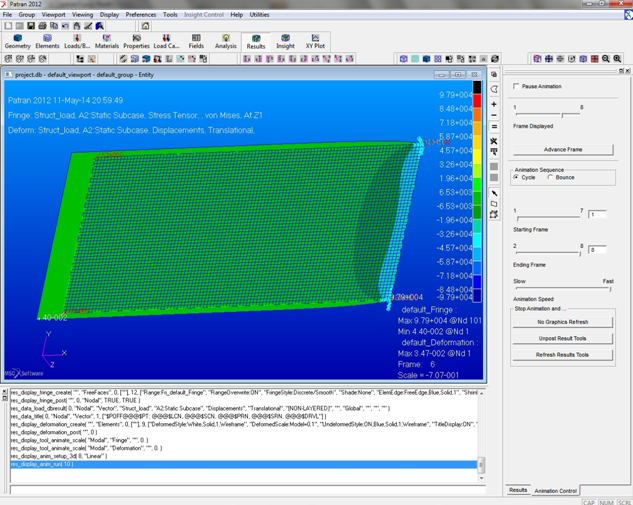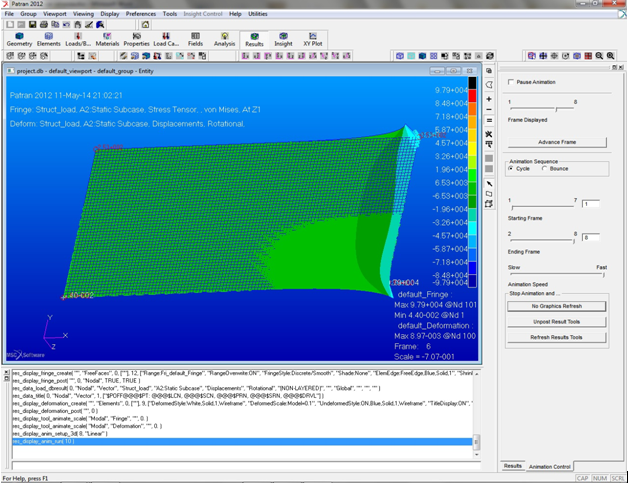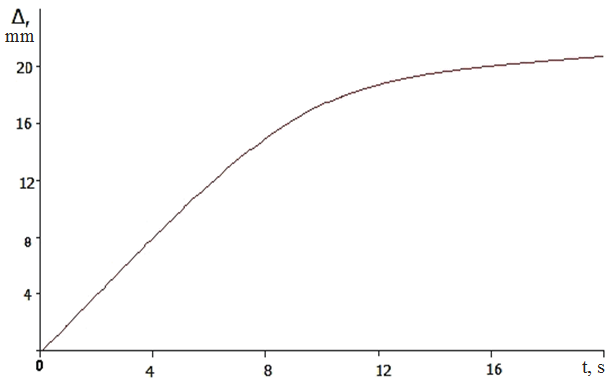MODELING MICROACCELERATION INDOOR ENVIROMENT OF SPACECRAFT CAUSE THERMAL IMPACT
Седельников А. В.1, Сербаева С. А.2, Потиенко К. И.2
1Кандидат физико-математических наук,
2студент,
Самарский государственный аэрокосмический университет имени академика С.П. Королёва (национальный исследовательский университет)
МОДЕЛИРОВАНИЕ МИКРОУСКОРЕНИЙ ВНУТРЕННЕЙ СРЕДЫ КОСМИЧЕСКОГО АППАРАТА, ВЫЗВАННЫХ ТЕПЛОВЫМ УДАРОМ
Аннотация
Проведено моделирование микроускорений внутренней среды космического аппарата, возникающих от теплового удара при погружении космического аппарата и выходе из тени Земли. Для моделирования использован пакет “NASTRAN”. Получены собственные формы деформации больших упругих элементов космического аппарата. Упругие элементы при моделировании представлялись однородными пластинами.
Ключевые слова: тепловой удар, микроускорения, космический аппарат.
Sedelnikov A. V.1, Serbaeva S. A.2, Potienko K. I.2
1PhD in Physic and Mathematical Sciences,
2student,
Samara State Aerospace University named after academician S.P. Korolyov
MODELING MICROACCELERATION INDOOR ENVIROMENT OF SPACECRAFT CAUSE THERMAL IMPACT
Abstract
The modeling of accelerations indoor environment of spacecraft arising from thermal impact by immersing the spacecraft and output of the Earth's shade. For modeling used «NASTRAN». Got own shape deformations of large elastic elements of spacecraft. Elastic elements in modeling represent homogeneous plates.
Keywords: thermal impact, microaccelerations, spacecraft.
The problem of providing and checking given level microacceleration in conducting of gravity-sensitive processes onboard the spacecraft is relevant. For this purpose used various design techniques [1-3]. The main [4] contribution to field microaccelerations indoor environment of spacecraft brings a constructive microaccelerations arising from oscillation of large elastic elements. Fractal property of constructive component microaccelerations's allows us to estimate the maximum values microaccelerations in the area of process equipment [5]. In the case of orbital eclipse period the main source of microaccelerations will not only oscillations of large elastic elements. In immersion spacecraft and exit of the Earth shadow a large elastic elements are experiencing thermal impact. Due to this impact may be briefly significant microaccelerations in internal environment of spacecraft [6]. These microaccelerations should be taken into account in modeling [7]. In this work estimated the microaccelerations of rotational motion model of spacecraft around the center of mass [4]. There are researches of a more complex character evolution of spacecraft relative to the center of mass [8]. Score from model of rotational motion the spacecraft is overpriced compared to the more complex evolution of spacecraft [6].
As the elastic element model was chosen homogeneous plate. Numerical simulation was carried in "NASTRAN". Data for modeling corresponding to certain variant technological laboratory "OKA-T" [4]. As a result of setting material properties of plate MA2 were obtained data on thermal deformations elastic elements (figure 1, 2), moving the end points of plate is rigidly attached to the body of spacecraft ( figure 3).
The results obtained in general correspond to the results of paper [9]. In it temperature deformations of big elastic elements of the spacecraft were also considered. Thus the orbit of the spacecraft contained a shadow site. In this paper considered a beam model of elastic element. Evaluation of microacceleration from thermal deformation of elastic elements on beam model has several drawbacks:
- inadequate representation of heat transfer from the surface of solar panel.
(The beam has no surface. The heat transfer from a beam in the form of radiation
under Stephane-Boltsman's law absolutely is absent. In case of a plate this radiation plays an essential role [10]);
Fig. 1 – Deformation of elastic element in the plane
Fig. 2 – Torsional strain of the elastic member
Fig. 3 – Moving the end points of elastic element
- point fixing solar panels to the body of
(All impulse from temperature expansion or compression is transferred to the spacecraft case in a fastening point. Thus the beam remains rectilinear. It causes significantly the overestimated assessment of microaccelerations. In case of a plate only the part of an impulse is transferred through fastening knot on the korpuskosmichesky device. Its essential part promotes deformation of a plate. It gets out of a rectangular shape (figure 1 and 2)).
- inadequate representation the temperature field inside elastic element;
(Thickness of a beam is negligible. In this case the field of temperatures the solar battery will be uniform. Such it also remains after temperature expansion or compression. As the beam doesn't get out of a rectilinear shape. In case of a plate its temperature field unevenly. At deformation of a plate after temperature expansion or compression it becomes even more difficult).
In the work to assess microacceleration was selected model of plate. When modeling the konechnoelementny grid was used. Geometrically final element got out the rectangular. The approximating dependences were linear. It is caused by a small absolute value of deformations of points of the solar panel in the course of temperature blow.
In the future planned to complicate the model of elastic element. In reality the solar panel represents a difficult design. This design consists of a power framework and photo cells pasted on it. The framework is carried out from a magnesian alloy or composite materials. Therefore properties of such solar panel are significantly non-uniform. Representation elastic elements of plate will be considered as a test model for more complex finite-element model. The carried-out calculations show need of the accounting of microaccelerations which arise because of temperature deformations of big elastic elements of the spacecraft. Therefore existence of a shadow site of an orbit is undesirable for carrying out long gravitational and sensitive processes.
References
- A.V. Sedelnikov, A.A. Kireeva Alternative solution to increase the duration of microgravity calm period on board the space laboratory // Acta Astronautica. – 2011. – Vol. 69. – № 6-7. – P. 480-484.
- A.V. Sedelnikov, D.P. Podlesnova Space vehicle "Spot-4" as the example of successful struggle with low-frequency components of microacceleration // Proceedings of the institute of higher education. The region of North Caucasus. – 2007. – №. 4. – P. 44-46.
- A.V. Sedelnikov Control of microaccelerations as the major characteristics of space laboratory of specialized technological appointment as constructive methods // Testing. Diagnostics. – 2014. – №. 7. – P. 57-63.
- A.V. Sedelnikov The problem of microaccelerations: from comprehension up to fractal model (Moscow, Russian Academy of Sciences: The Elected Works of the Russian school, 2012), 277 p.
- A.V. Sedelnikov On the fractal properties microaccelerations // Microgravity Scienes and Technology. – 2012. – Vol. 24. – № 5. – P. 345-350.
- A.V. Sedelnikov Influence of temperature deformations of space vehicle large elastic structural elements in microacceleration estimate // Proceedings of Samara Scientific Center Russian Academy of Sciences. – 2012. – Vol. 14. – № 1(2). – Р. 505-509.
- A.V. Sedelnikov, M.I. Kazarina Influence of elastic elements temperature deformations on dynamics of the "NICA-T" spacecraft // Messenger of Moscow Aviation University. – 2011. – Vol. 18. – № 2. – P. 47-51.
- A.V. Doroshin Homoclinic solutions and motion chaotization in attitude dynamics of a multi-spin // Communications in Nonlinear Science and Numerical Simulation. – 2014. – Vol. 19. – Issue 7. – P. 2528-2552.
- M. Narasimha, K.K. Appu Kuttan, K. Ravikiran Thermally induced vibration of a simply supported beam using finite element method // International journal of engineering science and technology. – 2010. – Vol. 2. – № 12. – P. 7874-7879.
- A.V. Sedelnikov Influence of temperature deformations of space vehicle large elastic structural elements in microacceleration estimate // Proceedings of Samara Scientific Center, Russian Academy of Sciences. – 2011. – Vol. 13. – №4. – P. 1022-1026.



